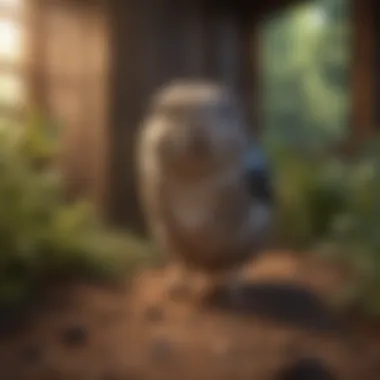Unveiling the Truth: Effectiveness of Animal Repellers Decoded


Animal Species Profile
Animal Repellers have become a vital tool in managing pest populations, but how effective are they truly in deterring these unwanted critters?
When considering the key points that will be discussed, it is essential to highlight the scientific evidence and practical applications of animal repellers. Understanding their efficacy is crucial for safeguarding properties and ensuring critters stay at bay.
Animal Species Profile
As animal lovers and property owners, it is imperative to grasp the effectiveness of these devices in separating fact from fiction.
Raccoons
Raccoons are a common nocturnal mammal with distinctive bandit-like facial markings. Their natural habitats range from forests to urban areas, showcasing their adaptability. Known for their dexterous front paws and keen intelligence, raccoons are proficient at finding food sources almost anywhere, making them a nuisance for many homeowners.
Squirrels
Squirrels are small rodents known for their bushy tails and nimble movements. These creatures inhabit various environments, predominantly forests and urban parks. Squirrels are adept climbers and jumpers, making them quick and agile when foraging for food. Their curious nature often leads them into contact with human settlements, posing potential challenges for property owners.
Conservation & Wildlife Efforts
While animal repellers aid in managing pest control, understanding the broader context of wildlife conservation is essential.
Conservation Status
Both raccoons and squirrels are considered abundant species, with stable populations in North America. Despite this, conservation efforts strive to maintain a balance in their ecosystems to prevent overpopulation and habitat degradation.
Threats to the Species
Human urbanization and habitat loss pose significant threats to raccoons and squirrels. Encounters with vehicles, domestic pets, and environmental pollution contribute to mortality rates among these creatures.
Animal Behavior & Psychology
To effectively deter these critters, delving into their behavior and psychology is crucial for devising practical solutions.
Communication and Language Cues
Raccoons and squirrels rely on vocalizations, body language, and scent markings to communicate. Understanding these signals can aid in interpreting their intentions and reactions to potential threats.


Reproductive Behavior and Parenting
Both species exhibit complex reproductive behaviors, with raccoons being solitary animals and squirrels living in small family groups. Awareness of their mating seasons and nesting habits can help in implementing effective animal repelling strategies.
Unique Facts & Trivia
Exploring the unique traits and behaviors of raccoons and squirrels adds depth to our understanding of these fascinating creatures.
Raccoons
Did you know that raccoons have a highly developed sense of touch, with their front paws having a similar dexterity to human hands? This ability allows them to manipulate objects with precision and agility.
Squirrels
Squirrels are known for their remarkable memory skills, capable of storing thousands of nuts and seeds in various locations for future consumption. This behavior not only aids in their survival during scarce food periods but also contributes to the dispersal of plant species.
Pet Care & Tips
For pet owners seeking to protect their properties from unwanted critters, implementing effective animal repellers can be paramount.
Choosing the Right Repeller
Selecting a repeller that targets the specific species plaguing your property is crucial for optimal results. Consider factors such as the range of the device, frequency of use, and environmentally friendly options.
Habitats and Nesting Sites
Identifying and securing potential entry points and nesting sites for raccoons and squirrels can deter them from establishing residence on your property. Implementing physical barriers and repellent technologies can reinforce these preventive measures.
Creating a comprehensive guide to the effectiveness of animal repellers offers valuable insights into managing pest populations and protecting properties from unwanted critters. By delving into the behavior, conservation status, and unique traits of raccoons and squirrels, readers can make informed decisions on implementing sustainable pest control strategies.
Introduction
The realm of animal repellers is vast and essential in a modern world where urban and wildlife often collide. Understanding the efficacy of these devices is crucial for those seeking to protect properties from unwanted critters. In this article, we will dissect the effectiveness of animal repellers, separating fact from fiction to provide readers with a nuanced understanding of their utility.
Understanding Animal Repellers
How Do Animal Repellers Function?
Animal repellers operate on advanced technologies designed to deter pests effectively. These devices emit signals or substances that are unpleasant or disruptive to animals, prompting them to avoid the protected area. By utilizing innovative mechanisms, such as ultrasonic waves or flashing lights, animal repellers create an environment that discourages critters from trespassing. The key characteristic of this functionality lies in its non-invasive approach, offering a humane and eco-friendly solution to pest control. Despite its effectiveness, some may question the long-term impact on wildlife behavior, which warrants further exploration in this article.


Types of Animal Repellers
Various types of animal repellers cater to different needs and environments, ensuring versatility in safeguarding properties. From ultrasonic devices to water sprinklers, each type utilizes distinct strategies to repel pests effectively. The key characteristic of these repellers is their adaptability to diverse settings, making them a popular choice among property owners. However, it is essential to consider the limitations of each type, such as range or battery life, to maximize their efficacy. Understanding the unique features and drawbacks of various animal repellers is vital in selecting the most suitable option for specific pest control requirements.
The Science Behind Animal Repellers
In this article, we delve into the intricate workings of animal repellers, shedding light on the crucial role played by scientific principles. Understanding the science behind these devices is paramount in evaluating their effectiveness in repelling pests and safeguarding properties. By delving into the core mechanisms powering animal repellers, readers can grasp the systematic approach these devices employ to deter unwanted critters effectively.
Infrared Technology in Animal Repellers
Detection Mechanisms
Delving deeper into the domain of animal repellers, the detection mechanisms serve as a cornerstone in the efficacy of these devices. The utilization of infrared technology revolutionizes the detection of pests, enabling precise identification of intruders based on their heat signatures. This feature distinguishes detection mechanisms in animal repellers, providing a proactive defense system against a variety of unwelcome visitors. Its ability to pinpoint organic warmth amidst the background temperatures elevates the efficiency of surveillance, making it a popular choice for enhancing security measures in pest control strategies. While the unique feature of detection mechanisms lies in their ability to distinguish between living organisms and inanimate objects, its drawback may lie in potential interference from external heat sources, impacting accuracy under specific environmental conditions.
Effectiveness of Infrared Sensors
As we navigate the realm of animal repellers, the effectiveness of infrared sensors emerges as a critical aspect contributing to their overall performance. The utilization of infrared sensors enhances the sensitivity and responsiveness of these devices, ensuring prompt detection of any approaching pests. The key characteristic of these sensors lies in their ability to detect subtle variations in heat signatures, even in low-light conditions, optimizing their performance across diverse settings. This advanced feature makes infrared sensors a favored choice for ensuring the reliability and accuracy of animal repellers in safeguarding properties. While the unique advantage of infrared sensors lies in their ability to operate efficiently regardless of ambient light levels, a potential drawback may manifest in their susceptibility to malfunctions due to extreme temperature fluctuations, necessitating periodic maintenance to uphold optimal functioning.
Effectiveness of Animal Repellers
In this article, we delve into the pivotal topic of the effectiveness of animal repellers, aiming to separate fact from fiction and provide readers with a thorough understanding of these devices. Animal repellers play a crucial role in deterring pests and safeguarding properties from unwanted critters, making their effectiveness a key aspect of consideration for property owners and animal enthusiasts. Understanding the mechanisms behind animal repellers and evaluating their performance is essential for making informed decisions about pest control strategies.
Factors Influencing Effectiveness
Placement of Repellers
The placement of repellers is a critical factor that significantly influences their overall effectiveness. The strategic positioning of these devices in specific locations can maximize their impact in deterring pests. By placing repellers in areas where animals are likely to intrude, such as near entry points or potential nesting sites, the chances of success increase. Additionally, considering the range and coverage of the repeller is essential to ensure optimal performance.
Environmental Conditions
Environmental conditions play a vital role in determining the efficacy of animal repellers. Factors such as weather, terrain, and surrounding vegetation can impact the device's ability to repel animals effectively. For instance, heavy rainfall or extreme temperatures may affect the repeller's functionality, limiting its performance. Choosing repellers designed to withstand various environmental conditions is paramount for long-term effectiveness.
Common Criticisms
Variable Results
One common criticism surrounding animal repellers is the variability in results experienced by users. While some individuals report significant success in deterring pests, others may not achieve the desired outcomes. This discrepancy in effectiveness can be attributed to factors such as the type of pests present, placement of the repeller, and environmental variables. It is essential for users to set realistic expectations and be aware of the potential variability in results.
Adaptation by Animals


Another criticism of animal repellers is the ability of pests to adapt to the devices over time. Animals may become accustomed to the noise or ultrasonic waves emitted by the repeller, rendering it less effective in repelling them. To mitigate this issue, manufacturers often recommend changing the repeller's settings periodically or alternating between different types of repellers to prevent habituation. Understanding the potential for adaptation by animals is crucial for maintaining the long-term efficacy of these devices.
Case Studies on Animal Repellers
In the realm of animal repellers, case studies play a pivotal role in gauging the effectiveness of these devices. These real-life examples provide tangible evidence of how animal repellers have been applied in diverse scenarios to combat pest incursions. By delving into case studies, readers can glean insights into the practical outcomes of utilizing animal repellers, shedding light on their efficacy in safeguarding properties against unwanted critters. These case studies serve as valuable resources, offering a nuanced perspective on the varying results that users have experienced. Through an analytical lens, we can extract valuable lessons from these cases, enlightening us on optimal strategies for deploying animal repellers efficiently.
Residential Applications
Residential settings present a unique battleground for addressing pest issues, making the application of animal repellers particularly crucial. In this context, testimonials from users serve as a vital component in assessing the utility of these devices within domestic spaces. These testimonials not only provide first-hand accounts of individuals' experiences with animal repellers but also offer nuanced perspectives on their efficacy. Users share their triumphs and challenges, giving an authentic portrayal of how these devices function in real-world scenarios. Their feedback serves as a valuable compass for others navigating the terrain of pest control, showcasing the practical benefits and limitations of animal repellers within residential environments.
Testimonials from Users
Testimonials from users constitute a key pillar in evaluating the impact of animal repellers in residential applications. These testimonials serve as authentic reflections of users' encounters with critter infestations and their subsequent use of animal repellers as protective measures. Through these testimonials, readers gain insights into the real-world performance of these devices, learning about their effectiveness in deterring pests and safeguarding homes. Users articulate their satisfaction levels, detailing the changes observed after implementing animal repellers on their properties. Understanding these testimonials is vital for prospective users, as they offer a glimpse into the practical implications and outcomes of deploying animal repellers within residential settings.
Success Stories
Complementing testimonials, success stories paint a vivid picture of the triumphs achieved through the strategic utilization of animal repellers. These narratives spotlight instances where individuals have overcome persistent pest challenges by integrating animal repellers into their pest management strategies effectively. Success stories celebrate the tangible outcomes resulting from the adoption of these devices, showcasing how individuals have reclaimed their living spaces from invasive critters. By delving into these success stories, readers gain inspiration and practical insights on maximizing the potential of animal repellers in residential applications. These stories underscore the transformative impact that these devices can have when employed judiciously, reinforcing their role as indispensable tools in the fight against unwanted pests.
Practical Tips for Using Animal Repellers
In the realm of animal repellers, mastering practical tips is paramount for ensuring efficacy in deterring pests effectively. These tips serve as the backbone of successful pest management strategies, offering invaluable insights into optimizing the functionality of animal repellers. By implementing the following guidelines, individuals can enhance the performance of these devices and safeguard their properties from unwanted intruders.
Optimizing Repeller Performance
Strategic Placement
Strategic placement plays a pivotal role in maximizing the effectiveness of animal repellers. The strategic positioning of these devices is crucial in targeting specific areas prone to pest infestation. By identifying key entry points or common pathways used by animals, users can strategically position the repellers to create an inhospitable environment for pests. This method ensures comprehensive coverage and enhances the overall efficiency of the repellent system. Moreover, strategic placement minimizes blind spots and maximizes the repellent's reach, significantly improving its ability to repel a wide range of pests effectively.
Regular Maintenance
Regular maintenance is essential for ensuring the longevity and optimal performance of animal repellers. Conducting routine checks and maintenance procedures helps prevent issues such as battery failure, sensor malfunctions, or physical damage that could compromise the device's functionality. Cleaning the repeller regularly to remove dirt, debris, or obstructions ensures unobstructed operation. Additionally, checking for any signs of wear and tear and promptly addressing any issues can prevent potential breakdowns and prolong the lifespan of the device. By prioritizing regular upkeep and maintenance, users can optimize the performance of their animal repellers and ensure continuous protection against unwanted pests.
Conclusion
In the vast realm of animal repellers, the significance of drawing a conclusion cannot be overstated. As we dissected the efficacy and functionality of these devices, it becomes evident that arriving at a clear denouement is vital for individuals considering their implementation. Combining the scientific research we have explored, along with the practical insights provided, allows for a well-rounded assessment of the real-world utility of animal repellers. This section serves as a gateway to synthesizing all the information amassed and aids in making informed decisions when dealing with potential pest issues.
Final Thoughts on Animal Repellers
Evaluating Effectiveness
Delving into the core aspect of assessing the effectiveness of animal repellers unveils a crucial component in evaluating the practical utility of these devices. Understanding how these repellers fare against different pests and varying environmental conditions is paramount in discerning their overall value. The effectiveness of animal repellers lies not only in deterring pests but also in ensuring the longevity of their impact. This evaluation process, though meticulous, offers a comprehensive insight into the capabilities of the repellers in defending properties from unwanted intruders.
Future Perspectives
Looking ahead to the future of animal repellers provides a glimpse into the evolving landscape of pest management. Embracing advancements in technology and design, future perspectives in animal repellers promise enhanced efficiency and effectiveness in repelling pests. The key characteristic of this forward-looking approach is the integration of sustainability and eco-friendliness, ensuring that repellers not only protect but also maintain harmony with the environment. While there may be challenges in adopting these future perspectives, the benefits of increased efficacy and reduced ecological impact position them as a promising direction for pest control strategies.







